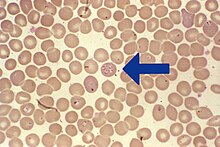Texas Fever (disease)
| Babesia | |
|---|---|
 |
|
| Scientific classification | |
| Domain: | Eukaryota |
| (unranked): | SAR |
| (unranked): | Alveolata |
| Phylum: | Apicomplexa |
| Class: | Aconoidasida |
| Order: | Piroplasmida |
| Family: | Babesiidae |
| Genus: | Babesia |
| Species | |
|
Babesia bigemina |
|
Babesia bigemina
Babesia bovis
Babesia caballi
Babesia canis
Babesia cati
Babesia crassa
Babesia divergens
Babesia duncani
Babesia felis
Babesia gibsoni
Babesia herpailuri
Babesia jakimovi
Babesia major
Babesia microti
Babesia motasi
Babesia ovate
Babesia ovis
Babesia pantherae
Babesia sp. 'North Carolina dog'
Babesia (also called Nuttallia) is an Apicomplexan parasite that infects red blood cells, transmitted by ticks. Originally discovered by the Romanian bacteriologist Victor Babeș, over 100 species of Babesia have since been identified.
Babesia species infect livestock worldwide, wild and domestic vertebrate animals and occasionally humans where it causes the disease babesiosis. In the United States, B. microti is the most common strain of the few which have been documented to cause disease in humans.
Babesia is a protozoan parasite found to infect vertebrate animals, mostly livestock mammals and birds, but also humans. Common names of the disease, which Babesia microti causes are Texas cattle fever, redwater fever, tick fever, and Nantucket fever. The disease it causes in humans, babesiosis, is also called piroplasmosis.
Due to historical misclassifications, the protozoan has been labeled with many names, including Nuttallia; the microbiological community changed the name Babesia to Theileria based on evidence from 2006. The sequence published in 2012 shows, that the species belongs to neither Babesia nor Theileria but instead to a separate genus.
...
Wikipedia
